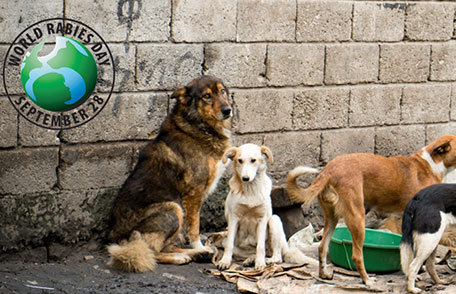For more than a century, rabies, a viral disease spread by animal bites, has had an effective vaccination. Despite this, people continue to die as a result of it. Rabies kills nearly every individual who develops clinical signs of the disease, making it one of the deadliest infectious diseases on the planet.
Africa is responsible for 36.4 percent of the 59,000 human rabies deaths per year. Rabies is endemic in Kenya, where it is believed that 2,000 people die each year.
The country is implementing a plan to eliminate rabies-related human mortality by 2030, beginning with a few pilot counties and gradually expanding to the rest of the country.
Kenya’s rabies elimination strategy, which began in 2014, comprises mass dog vaccination, fast rabies vaccine distribution, public education, and increased rabies surveillance in both animal and human populations. However, improvement is gradual, as it is in many other poor countries. Low levels of political commitment are one of the challenges, partly due to a lack of evidence on the disease’s true public health impact.
Get free, unbiased, and evidence-based news delivered to your inbox.
Many countries have increased their rabies control efforts in recent years by expanding mass dog vaccination programs. They’ve also offered pre-exposure and post-exposure immunizations, as well as rabies education to communities. Rabies has been eradicated from domestic dog populations in the majority of industrialized countries.
Apart from these efforts, ensuring that healthcare staff are aware of the disease and know what to do is an important part of ending rabies deaths. We set out to evaluate levels of rabies awareness and management among healthcare personnel in south-eastern Kenya, a region with a high number of rabies cases, in a recent study.
Many were found to be unprepared to diagnose the disease in all of its phases. Only around a quarter were aware of the World Health Organization’s (WHO) classification system for bite wounds. Few people were aware of international recommendations for the use of post-exposure vaccinations.
Stockpiles of efficacious vaccinations and immunoglobulin were also discovered.
Our research identifies potential to customize healthcare training programs – both pre-service and ongoing – to eliminate rabies. Prevention and control should be prioritized.
Our research
The domestic dog, man’s greatest friend, is the leading cause of human rabies cases. To avoid sickness and death after a dangerous bite, two important procedures must be followed in quick succession.
For at least 15 minutes, the wound must be cleansed thoroughly with clean running water and soap.
This should be followed by an injection of rabies vaccine on the day of the bite.
Multiple injections over the course of one month must follow. In the case of a severe bite, the patient would need immunoglobulin as well as the vaccine.
The reduction of risk of exposure to rabies depends on the type of treatment received at a health facility. A person bitten by a dog carrying rabies is more likely to develop the disease if the wound isn’t cared for properly and if they don’t receive the rabies vaccine (and immunoglobulin for severe exposure). This can be due to a lack of awareness of bite management by healthcare workers, unavailability of rabies vaccines and immunoglobulin, or availability of poor quality vaccines.
We visited 42 health facilities and interviewed 73 healthcare workers. They included medical officers, nurses, clinical officers, pharmacists, pharmacy and laboratory technologists, and public health officers.
Many healthcare workers didn’t know that encephalitis – inflammation of the brain – is a differential diagnosis for rabies. They, therefore, didn’t suspect rabies in patients with encephalitis. Less than a quarter of the healthcare workers were aware of the WHO categorisation of bite wounds that guides the use of post-exposure prophylaxis. One in 12 reported they knew the indication of rabies immunoglobulin.
In addition, healthcare workers were not fully informed about the latest WHO recommendations on the appropriate treatment of patients presenting with dog bites.
A good example is the route of administration of the vaccine. WHO has recommended injection within the layers of the skin rather than injecting the vaccine into muscles. By adopting this dose-saving route, the healthcare system could serve up to five times more bite patients for the same vaccine amount that treats one patient.
Thorough wound washing is also key. But only a third of the healthcare workers we spoke to said that they would do so for a category two-bite – where the animal nibbles on uncovered skin or the patient present with minor bite(s) or scratch(es) without bleeding.
For category 3 bites, in which for example the animal licks broken skin or the patient presents with single or multiple bites, 43% of the respondents reported they would clean the wound.
The stocking of vaccines was another major issue. In our study, rabies vaccines were available in only 12% of the health facilities we visited with stock-out periods reported of up to 28 weeks.
We found that none of the health facilities had rabies immunoglobulin in stock at the time of the study.
Tackling the problem
Rabies control and elimination require a concerted effort by the government, private sector and the community. By making the rabies vaccine available for both humans and animals, and creating awareness among healthcare workers and the community, Kenya can achieve the goal of ending deaths from human rabies by 2030.
But deliberate efforts need to be made. The most important is that healthcare workers need to be fully informed about the latest best practice. Integrating mass dog vaccination, provision of rabies vaccines for humans, adopting the latest WHO recommendations, risk assessment through sharing information between the health and veterinary sectors, and continuously training healthcare workers on proper management of bite patients and human rabies cases including diagnosis, are all critical for the elimination of rabies in Kenya.
Nobody should be dying of rabies. Not when there is a 100-year-old effective vaccine.



